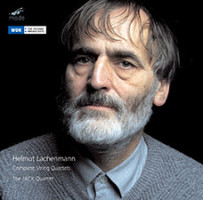A Rare Gem from mode: The JACK Quartet Performs Helmut Lachenmann’s String Quartets
|
Mike Silverton [March 2014.]
Helmut Lachenmann’s string quartets – Gran Torso (1972), Reigen seliger Geister (1989) and Grido (2000-01) – evolve, and always within the composer’s unique and uniquely challenging idiom, from disjunct near-stasis to something like a glimpse of the past. Good performances exist on other labels. I presume to describe mode 267 as a rare gem on the strength of the JACK Quartet’s especially convincing readings (Christopher Otto, Ari Streisfeld, violins; John Pickford Richards, viola; Kevin McFarland, cello) and West German Radio’s superior production (Stephan Schmidt, producer-editor). Gran Torso, with its stretches of barely audible activity, stands as a take-it-or-leave-it declaration of uniqueness, occupying an art-music sector, as it does, where distinctions of sound and noise matter not. Lachenmann never relinquishes his challenges to players: These three works fairly bristle with “extended technique.” While one hears nothing vaguely resembling Gluck’s “Dance of the Blessed Spirits,” Reigen seliger Geister does have its rhythmically propulsive passages. (The composer is not without a sense of humor. As another eponymous example, it requires a far keener ear than mine to detect the German national anthem in a favorite work, Tanzsuite mit Deutschlandlied, for orchestra and string quartet: Arditti String Quartet, Radio-Symphony Berlin, Olaf Henzold conducting; Montaigne CD MO 782019, reissued in 2000 on Montaigne 782130.) Grido’s “glimpse of the past,” even so tentatively suggested, is a gross exaggeration. The composer’s way with beyond-the-pale sounds defers here and there to moments of continuity I hear as filament-fine gestures to old-fashioned music-making – to continuity, if you prefer. No matter. Grido is a fascinating work. I’m with Elvis Costello: Writing about music is like dancing about architecture. For this listener Lachenmann’s art operates on two levels. First, we’ve the direct and pleasurable experience of abstract, largely non-narrative or, if ever so vaguely narrative, challenges to comprehension that are never less than engaging, all the more in these three quartets – a traditionally revelatory medium – a composer’s aesthetic unfiltered. The second level, with its manifesto-like aspects, serves so to speak as wordless position papers. Lachenmann has taken a rarefied yet influential school, beginning (among others) with Webern, to one of its farthest outposts, quite as if one had no choice in the matter. I wonder – his genius aside – whether this manner of steadfastness accounts for the music’s capacity to engage one’s brain along with one’s gut. * * * Postscript: Frequent contributor Walt Mundkowsky points out that the Elvis Costello quip, “…dancing about architecture,” is attributed to many people. See http://home.pacifier.com/~ascott/they/tamildaa.htm
[More Mike Silverton, mode]
[More
Lachenmann]
[Previous Article:
Sweet Blandishment]
[Next Article:
Concerto Concentrations 2.]
|
